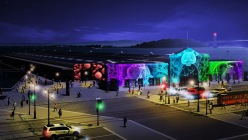Most of us take it as a given that “look don’t touch” is no way to encourage budding scientists. And every good teacher knows the stay-in-your-seats, nose-in-your-textbooks approach to pedagogy is no way to get anyone interested in the natural world. But when San Francisco’s Exploratorium first opened in 1969, it pioneered the practice of hands-on “informal learning” through real life experience.
Today visitors to the Exploratorium know the place as a giant fun-house of sensory stimulation and touch-and-feel scientific experimentation. Over the past 43 years, loads of Bay Area families have made the trek to the Palace of Fine Arts so their kids can tinker to their hearts’ delight.
As of Thursday, April 17, 2013, the long schlep is over. From 10:00am until 11:00pm on opening day, the new Exploratorium at Pier 15 will host outdoor exhibits, demonstrations, and activities to celebrate its lovely indoor/outdoor space just a few blocks from the Ferry building and the Embarcadero BART. The museum’s increased accessibility means it’s not just a locals-only secrete anymore: the bridge-and-ferry crowd, not to mention the tourists are sure to swarm to the museum after a pastry at the Ferry Building.
One of the first things you see at the new facility is a sign that says “You Can’t Fail a Museum.” And with three times more space and 150 new exhibits to discover, you can’t age out of it either. The experience begins even before you enter the museum: the atrium features visitor lockers that become musical notes when you hold the handles. The new site expands on the museum’s groundbreaking tradition to offer exhibits that encourage touching, tinkering, and interactive investigating.

George Cogan, the new Chairman of the Exploratorium’s Board of Directors, said, “The bigger mission of the Exploratorium is to foster a more perfect democracy.” The museum seeks to inspire visitors to think for themselves, rather than accept whatever truth is marketed to them. “Science is too important to leave to politicians,” Cogan continued. “We as citizens have a responsibility to learn about these things and ask questions that influence what we do around the world.”



